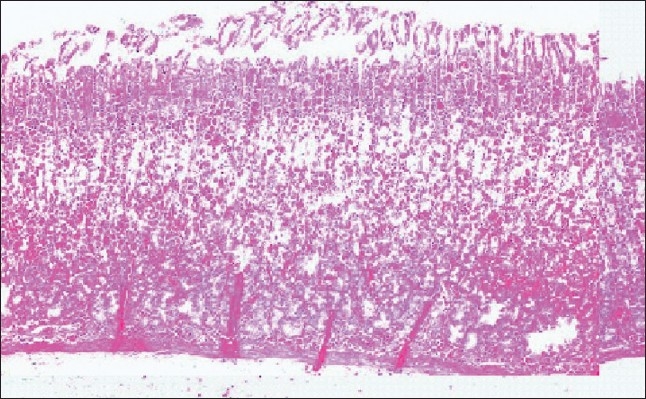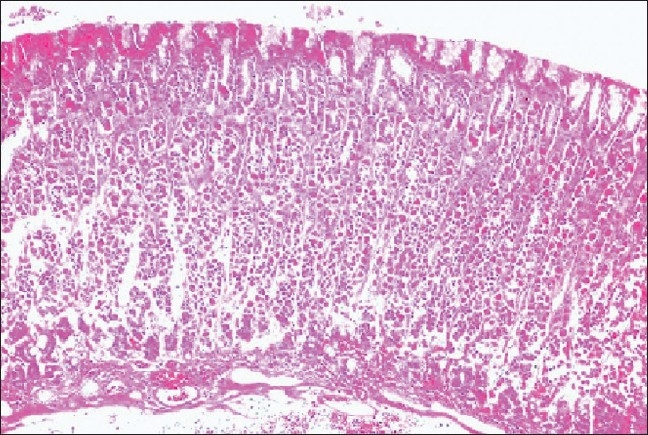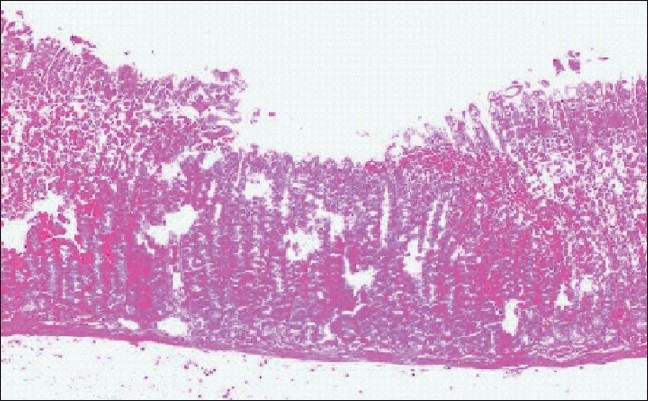Abstract
Gastric ulcer is one of the most prevalent gastrointestinal disorders, which affects approximately 5%-10% of people during their life. The ulcer is an open sore that develops on the inside lining of the stomach (a gastric ulcer) or the small intestine (a duodenal ulcer). Both types of ulcers are also referred to as peptic ulcer disease. The present study was carried out to investigate antiulcer activity of aqueous extract of fruits of Momordica cymbalaria Hook f. Initially the aqueous extract of M. cymbalaria was subjected to acute oral toxicity study according to the Organisation for Economic Co-operation and Development (OECD) guidelines, based on which, 500 mg/kg dose of aqueous extract was selected for the study. The animals were pretreated before inducing ulcer. For inducing ulcer in the rats, 80% ethanol was used. Various parameters such as area of gastric lesion, nonprotein sulfhydryls (NP-SH) concentration, gastric wall mucus concentration, total acidity and volume of gastric content; and histopathological parameters like hemorrhage, edema, erosion, ulceration were studied in the control group and pretreated groups with aqueous extract of fruits of Momordica cymbalaria (500 mg/kg) and standard drug lanzoprazole (30 mg/kg). Pretreatment with aqueous extract of M. cymbalaria fruits showed significant (P < 0.05) decrease in the total acidity and ulcer index. Improvements in all histopathological parameters were noticed in the M. cymbalaria-treated group. It also showed significant decrease in gastric lesion and NP-SH and gastric wall mucus concentrations in the M. cymbalaria-treated group. Overall the aqueous extract of M. cymbalaria fruits was shown to possess significant (P < 0.05) antiulcer property in rats. The polyphenols like quercetin reported from the plant may attribute to the antiulcer property of the extract.
Keywords: Antiulcer activity, aqueous extract, gastric ulcer, Momordica cymbalaria, Momordica tuberosa
INTRODUCTION
Momordica cymbalaria Hook f. is a wild crop, well known as Athalakkai in Tamil. The synonyms of Momordica cymbalaria are Momordica tuberosa Roxb. Cogn., Luffa tuberosa Roxb. It is available in various parts of India, and it is a highly acceptable wild vegetable across south India. The nutritional study of the fruits of Momordica cymbalaria have reported that they possess a high level of calcium, potassium and vitamin C, in addition to its high crude fiber content.[1] The fruits of Momordica cymbalaria have been reported to possess hypoglycemic activity in rats.[2,3] The fruit extracts of Momordica cymbalaria were shown to have antidiabetic and hypolipidemic properties.[4,5] The roots of this plant have been used by the natives of north Karnataka and Andhra Pradesh to treat some gynecological ailments and also to induce abortions.[6] The decoctions of Momordica cymbalaria fruits have been used in traditional medicine as a treatment for gastric ulcer. Although traditionally it is used for gastric ulcer, the plant has not been shown to possess antiulcer activity on the basis of scientific data.
Ulcer is an open sore that develops on the inside lining of the stomach (a gastric ulcer) or the small intestine (a duodenal ulcer). Both types of ulcers are also referred to as peptic ulcers. The most common symptom of a peptic ulcer is a burning or gnawing pain in the center of the abdomen (stomach). In the past, it was mistakenly thought that the main causes of peptic ulcers were lifestyle factors, such as diet, smoking, alcohol and stress. While these factors may play a limited role, it is now known that the leading cause of peptic ulcers is a type of bacteria called H. pylori . H. pylori can infect the stomach and small intestine; and in some people, the bacteria can irritate the inner layer of the stomach and small intestine, leading to the formation of an ulcer.[7] Peptic ulcer occurs due to an imbalance between the aggressive (acid, pepsin and Helicobacter pylori) and the defensive (gastric mucus and bicarbonate secretion, prostaglandins, innate resistance of the mucosal cells) factors.[8] Painkillers known as nonsteroidal anti- inflammatory drugs (NSAIDs), which include aspirin and ibuprofen, are the second most common cause of peptic ulcers. These types of painkillers can irritate the lining of the stomach and small intestine in some people, particularly if they are taken on a long-term basis.
Number of drugs, including proton pump inhibitors, prostaglandins analogs, histamine receptor antagonists and cytoprotective agents, are available for the treatment of peptic ulcer, but most of these drugs produce several adverse reactions, including toxicities, and may even alter biochemical mechanisms of the body upon chronic usage.[9] Hence herbal medicines are generally used in such chronic cases, wherein drugs are required to be used for long periods. Hence the present work was undertaken to investigate the antiulcer activity of aqueous extract of Momordica cymbalaria fruits in rats.
MATERIALS AND METHODS
Plant material
Plant material and chemicals: Momordica cymbalaria was collected from Aruppukottai, near Madurai, Virudhunagar district of Tamil Nadu, India. The fruits of the plant were botanically identified and authenticated by botanist Dr. R. Kannan. A voucher specimen of the herb (TUH No. 266) was deposited in the Department of Environmental and Herbal Sciences, Tamil University, Thanjavur. All the other chemicals and solvents used were of laboratory grade unless otherwise mentioned and purchased from S. D. Fine-chem Ltd., Mumbai, India.
Preparation of plant extract
Five kilograms of the fruit powder was extracted through successive solvent extraction in Soxhlet apparatus using the solvents Pet-ether (60-80), chloroform, ethyl acetate, methanol; and finally the marc was subjected to aqueous extraction by maceration in 15 volumes of purified water. The solvent extracts were used for phytochemical investigation. The aqueous extract (yield, 9.5%) was concentrated and dried at a temperature not exceeding 60°C in high vacuum (0.1 mmHg). The dried powder of the aqueous extract was suspended in distilled water and used for the following study.
Experimental animals
Male Wistar rats weighing 200 to 220 g were procured from Glenmark Pharmaceuticals, Navi Mumbai. All the animals were placed in polypropylene cages at controlled room temperature 24°C ± 1°C and relative humidity of 60% to 70% in animal house and maintained on standard pellet diet and water ad libitum. They were acclimatized to laboratory conditions for seven days before commencement of the experiment. Ethical clearance was obtained from Institutional Animal Ethical Committee. Acute oral toxicity study of aqueous extract of M. cymbalaria was carried out as per standard guidelines.[10,11]
Methodology
Male Wistar rats were divided into four groups of six animals each. Animals were fasted for 24 hours before the study but had free access to water. Animals in group I (normal control group) received only distilled water. The animals in group II received only distilled water. Group III animals were given lanzoprazole (30 mg/kg), which was used as standard; and group IV animals were given aqueous extract of M. cymbalaria at 500 mg/kg, p.o. After 1 hour of treatment with drugs, the three groups of animals (groups II, III and IV) were administered 80% ethanol 0.1 mg/kg, i.g., to induce gastric ulcer.[12]
Under light ether anesthesia, the abdomen was opened and pylorus was ligated without causing any damage to its blood vessels. The stomach was replaced carefully, and the abdominal wall was closed with interrupted sutures. The animals were deprived of water during the postoperative period. Four hours after ligation, stomachs were dissected out and contents were collected into clean tubes. Volume, pH and total acid content of gastric juice were determined. The contents were centrifuged, filtered and subjected to titration for estimation of total acidity. One milliliter of centrifuged and filtered gastric secretion was titrated against 0.1N sodium hydroxide using 1% phenolphthalein as indicator to find out the total acidity. The stomach was opened along the greater curvature and examined for ulcers. The ulcer index was evaluated using the method described earlier.[13] Various parameters such as area of gastric lesion, NP-SH concentration, gastric wall mucus concentration, total acidity and volume of gastric content; and histopathological parameters like hemorrhage, edema, erosion, ulceration were studied and compared between all the four groups of rats. Procedures for determination of all other parameters listed in Tables 1 and 2 were performed as per the reported procedures.[14,15]
Table 1.
Effect of aqueous extract of M. cymbalaria on gastric lesion, NP-SH concentration, wall mucus concentration, gastric volume, titratable acid and ulcer index in ulcer-induced rats

Table 2.
Effect of aqueous extract of M. cymbalaria on histopathological parameters of ulcer-induced rats

Statistical analysis
Statistical analysis was carried out using ANOVA, followed by Dunnet's multiple comparison tests using Graph pad PRISM software version 4.03. P values < 0.05 were considered significant.
RESULTS
Acute oral toxicity study
The male Wistar rats treated with aqueous extract of M. cymbalaria did not show any behavioral changes, toxic reaction or mortality up to 5000 mg/kg treatment. It was found to be safe at the dose of 5000 mg/kg. Therefore, LD50 of the aqueous extract of M. cymbalaria was found to be >5000 mg/kg.
Effect of aqueous extract of M. cymbalaria fruits on ethanol-induced ulceration is shown in Tabels 1 and 2. Area of gastric lesions was found to be reduced from 88.05 ± 0.81 to 26.00* ± 0.46 (P < 0.05). There was a significant reduction in NP-SH concentration, gastric wall mucus concentration and volume of gastric content, which is clear from the data in Table 1. The titratable acidity of the gastric secretions was found to be reduced from 128.42 ± 0.89 in the ulcer control group to 107.51 ± 0.57 in M. cymbalaria-treated group.
The gastro-protection offered by M. cymbalaria fruit extract (500 mg/kg) was comparable to that of the standard drug, lanzoprazole (30 mg/kg) (P < 0.05).
The histopathology of gastric mucosa of rats reveals a significant reduction in gastric erosion and lesions in M. cymbalaria-treated group [Figure 1], which is similar to that in the lanzoprazole-treated group [Figure 2], as compared to the control group [Figure 3].
Figure 1.

Histology of gastric mucosa of rats treated with aqueous ext. of Momordica cymbalaria fruits
Figure 2.

Histology of gastric mucosa of rats pre-treated with Lanzoprazole
Figure 3.

Histology of gastric mucosa of rats showing ulcer induced with 80% ethanol
DISCUSSION
The antiulcer property of Momordica cymbalaria fruits in rats is evident from its significant reduction in titratable acidity, the number of ulcer index (P < 0.05). The reduction in NP-SH concentration, gastric wall mucus concentration and volume of gastric content also confirms the antiulcer property of the tested material. The histopathological study also showed much reduction in gastric lesions; hemorrhage, erosion and ulceration suggested that M. cymbalaria could suppress gastric damage induced by ethanol [Figures 1–3].
The preliminary phytochemical analysis of M. cymbalaria extract showed the presence of flavonoids, cucurbitacins, momordicine and glycosides. It is also reported that the aqueous extract is rich in flavanol quercetin, which was earlier reported for its antiulcer property.[10] The cucurbitacins, momordicine are among the cytoprotective materials isolated from this plant. The antioxidant components from many plant extracts have been extensively confirmed for their antiulcerogenic efficacy.[16] It is suggested that these active compounds would be able to stimulate prostaglandin secretion and counteract the deteriorating effects of reactive oxidants in gastrointestinal lumen.[17,18] The antiulcer activity of M. cymbalaria may be attributed to its polyphenolic constituents, particularly quercetin, reported from it.[10] In this study, we observed that the aqueous extract of M. cymbalaria fruits provides significant antiulcer effect against gastric ulcers in rats, a fact that supports the traditional use of the decoction of M. cymbalaria fruits for its antiulcer effect.
Footnotes
Source of Support: Nil.
Conflict of Interest: None declared.
REFERENCES
- 1.Parvathi S, Kumar VJ. Studies on chemical composition and utilization of the wild edible vegetable Athalakkai (Momordica tuberosa) Plant Foods Hum Nutr. 2002;57:215–22. doi: 10.1023/a:1021884406024. [DOI] [PubMed] [Google Scholar]
- 2.Rao BK, Kesavulu MM, Apparao C. Antihyperglycemic activity of Momordica cymbalaria in lloxan diabetic rats. J Ethnopharmacol. 2001;78:67–71. doi: 10.1016/s0378-8741(01)00324-5. [DOI] [PubMed] [Google Scholar]
- 3.Kameswararao B, Kesavulu MM, Apparao C. Evaluation of antidiabetic effect of Momordica cymbalaria fruit in alloxan-diabetic rats. Fitoterapia. 2003;74:7–13. doi: 10.1016/s0367-326x(02)00297-6. [DOI] [PubMed] [Google Scholar]
- 4.Rao BK, Kesavulu MM, Giri R, Appa Rao C. Antidiabetic and hypolipidemic effect of Momordica cymbalaria Hook fruit powder in alloxan-diabetic rats. J Ethnopharmacol. 1999;67:103–9. doi: 10.1016/s0378-8741(99)00004-5. [DOI] [PubMed] [Google Scholar]
- 5.Grover JK, Yadav S, Vats V. Medicinal plants of India with anti-diabetic potential. J Ethnopharmacol. 2002;81:81–100. doi: 10.1016/s0378-8741(02)00059-4. [DOI] [PubMed] [Google Scholar]
- 6.Nadkarni AK. Indian Materia Medica. Bombay, India: Popular Prakashan Private Ltd; 1976. p. 127. [Google Scholar]
- 7.Dulcie AM, Vikash S, Roy O, Karl HP, Joseph DC. Cucurbitane triterpenoids from the leaves of Momordica foetida. Phytochem. 1997;45:391–5. [Google Scholar]
- 8.Tripathi KD. Essentials of Medical Pharmacology. New Delhi: Jaypee Brothers Medical Publishers (P) Ltd; 1999. Gastrointestinal Drugs: Drugs for peptic ulcers; pp. 628–42. [Google Scholar]
- 9.Ariyphisi I, Toshiharu A, Sugimura F, Abe M, Matsuo Y, Honda T. Recurrence during maintenance therapy with histamine H2 receptors antagonist in cases of gastric ulcers. Nikon Univ J Med. 1986;28:69–74. [Google Scholar]
- 10.Sari H, Sirpa OK, Marina IH, Hannu MM, Riitta AT. Content of the flavanols quercetin, myricetin and kaemferol in 25 edible berries. J Agri Food Chem. 1999;47:2274–9. doi: 10.1021/jf9811065. [DOI] [PubMed] [Google Scholar]
- 11.Organisation for economic co-operation and development, OECD Environment. Paris: health and safety publications; 1996. Guidance document on acute oral toxicity testing Series on testing and assessment No. 423. [Google Scholar]
- 12.Szelenyi L, Brune K. Possible role of oxygen free radical in ethanol induced gastric-mucosal damage in rats. Dig Dis Sci. 1988;33:865–71. doi: 10.1007/BF01550977. [DOI] [PubMed] [Google Scholar]
- 13.Vogel HG, Vogel WH. Drug discovery and evaluation (Pharmacological assays) Berlin: Springer Verlag Company; 1997. Activity on the gastrointestinal tract; pp. 486–7. [Google Scholar]
- 14.Borrelli F, Izzo AA. The plant kingdom as a source of antiulcer remedies. Phytother Res. 2000;14:581–91. doi: 10.1002/1099-1573(200012)14:8<581::aid-ptr776>3.0.co;2-s. [DOI] [PubMed] [Google Scholar]
- 15.Galati EM, Monforte MT, Tripodo MM, d’Aquino A, Mondello MR. Antiulcer activity of Opuntia ficus indica L.(Cactaceae): Ultrastructural study. J Ethnopharmacol. 2001;76:1–9. doi: 10.1016/s0378-8741(01)00196-9. [DOI] [PubMed] [Google Scholar]
- 16.Salvayre R, Braquet P, Perochot L, Douste-Blazy L. Comparison of the scavenger effect of bilberry anthocyanosides with various flavonoids. Flavonoids Bioflavonoids. 1982;11:437–42. [Google Scholar]
- 17.Pandian RS, Anuradha CV, Viswanathan P. Gastroprotective effect of fenugreek seeds (Trigonella foenum graecum) on experimental gastric ulcer in rats. J Ethnopharmacol. 2002;8:393–7. doi: 10.1016/s0378-8741(02)00117-4. [DOI] [PubMed] [Google Scholar]
- 18.Asuzu IU, Onu OU. Antiulcer activity of the ethanolic extract of Combretum dolichopetalum root. Int J Crude Drug Res. 1990;28:27–32. [Google Scholar]


